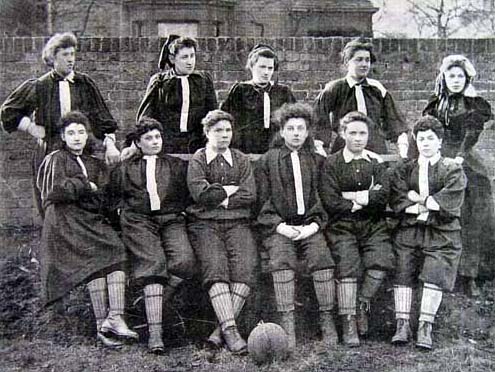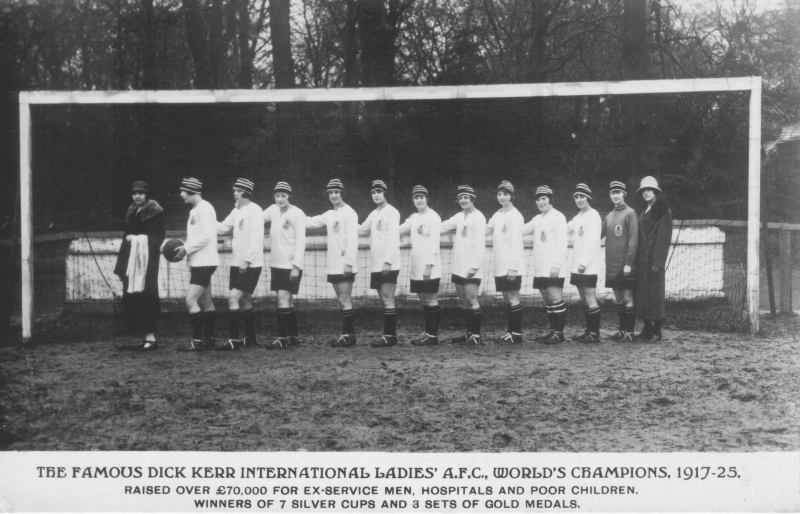The birth of women’s football
Written by Pam Preedy.
Girls Versus Boys
Football had always been a male preserve, but in December 1915, a match was played between Bromley Boys (National Team) and Vickers Girls:
The Bromley & Kentish Times reported on the match (7th July 1914).
“A game that finished up in a comical football match was played on the Queen’s Mead ground last Saturday … The game ended with a large amount of scoring, the Old Boys scoring 17 goals to the Ladies’ 1 … At the start the visitors (the Ladies) showed good form, but just before the interval they got too excited and soon lost their previous form.
At half-time the Old Boys had their hands tied behind them, and following this a great deal of laughter from the spectators was caused by the National players’ antics when they went to the ground, and when the girls were pushing their opponents off the ball when they went to kick it. Two or three of the girls were, during the second half, just walking round the field, each talking to one of the National players, and not taking any notice of the game, except when the ball came near them. “

It sounds great fun and was a forerunner of an upsurge of interest in women’s football. At the end of the 1914-15 season the men’s Football League was suspended. It was felt that to continue playing while young men were dying on the battlefields of France and Belgium was morally reprehensible, in spite of the fact that they had raised over £7,000 for the war effort.

The Rise of Ladies' football
Women’s football was not new in 1915; the first ladies’ match was played in 1881 when an Edinburgh-born theatrical agent, Alec Gordon, organised the first association match played at Hibernian’s Easter Road ground. The women’s game would continue to be associated with the theatre throughout the 1880s and 90s.
Then, in 1915, there was a national scandal; the frontline troops were being starved of shells. Not enough could be produced. More than 900,000 women stepped forward to work in the munitions factories across the country. Most factories employed a welfare officer to monitor the health, wellbeing and behaviour of their new female workforce. Sport, especially football, was encouraged and many munitions factories developed their own football teams.

The 'Munitionetes' football teams
The first ‘munitionettes’ teams were formed in 1916 at the William Beardsmore’s factory at Parkhead near Gretna in Scotland.In 1917 more teams formed around the munitions factories. In the early days, most women’s football sprang from the industrial heartlands in Scotland and the Midlands. Eventually teams were formed in the London area and the nearest team to Bromley was at the Dartford Vickers munitions factory.
The first women’s football tournament took place at Celtic Park on August 4th 1917. More substantial events would follow: the Coventry Cup and the Workington Women’s Football Competition. There was even an attempt at a league in Manchester and district.

The most famous of the tournaments was the Alfred Wood Munitions Girls Challenge Trophy or the Munitionettes’ Cup held in the North East of England.
Blyth Spartans beat Bolckow Vaughan 5-0, with 22,000 spectators turning out at Ayresome Park on May 14th 1918 to see Bella Reay score a hat-trick for Blyth.
Ladies football became popular, attracting large crowds – up to 53,000 in the 1920s. These women were amateurs and received no pay, merely travelling and accommodation expenses plus loss of pay. The money went to charitable organisations.
FA bans Ladies Football
On 5th December 1921 ladies football was banned by the FA as unsuitable for women. Perhaps the men did not like the competition!
There were the usual spurious arguments: that football was unsuitable for the female body. Some female doctors thought football physically harmful to women and feared they might be seriously injured. There were accusations of money being diverted to political organisations. The FA simply refused to allow their grounds to be used for women’s matches.
The girls were devastated and outraged: if women could do manual work for the war effort, then it was insulting to suggest that they were too delicate to play football. They played for the love of the game.
The ban remained in place for almost 50 years and it has taken a long time for women’s football to grow in popularity. But now it has arrived – come on the Lionesses!
A film showing women’s football in the 1920s.
Further your research
For more information visit the Bromley Historic Collections on the 2nd floor of Bromley Central Library to learn more about Bromley Borough’s history.
Originally published in Life in Bromley magazine (Issue 12, February 2023)
Images sourced via Wikimedia Commons
Videos via YouTube from British Pathe and the B.F.I.
